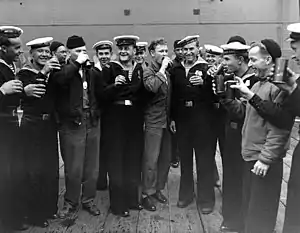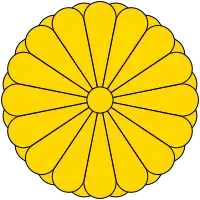جنگ روسیه-ژاپن
جنگ روسیه-ژاپن (روسی: Советско-японская война) درگیری نظامی در جنگ جهانی دوم بود که بلافاصله پس از نیمه شب در ۹ اوت ۱۹۴۵ آغاز شد، با تهاجم نظامی شوروی به منچوری به دولت دستنشانده امپراتوری ژاپن مانچوکوئو. اتحاد جماهیر شوروی سوسیالیستی و جمهوری خلق مغولستان به کنترل ژاپن بر مانچوکوئو، مغولستان داخلی، کره (کشور) شمالی، استان کارافوتو و جزایر کوریل پایان دادند. شکست ارتش کانتوگون ژاپنی به تسلیم ژاپن و خاتمه جنگ جهانی دوم کمک کرد.
| Soviet-Japanese War | |||||||||
|---|---|---|---|---|---|---|---|---|---|
| بخشی از جنگ اقیانوس آرام از جنگ جهانی دوم | |||||||||
 ملوانان و دریانوردان ایالات متحده و شوروی در کنار هم جشن میگیرند روز پیروزی بر ژاپن | |||||||||
| |||||||||
| طرفین درگیر | |||||||||
|
|
| ||||||||
| فرماندهان و رهبران | |||||||||
| |||||||||
| واحدهای درگیر | |||||||||
|
|
| ||||||||
| قوا | |||||||||
شوروی:
|
ژاپن:
| ||||||||
| تلفات | |||||||||
|
نیروهای ژاپنی:
ادعاهای شوروی:
| |||||||||
جستارهای وابسته
منابع
- LTC David M. Glantz, "August Storm: The Soviet 1945 Strategic Offensive in Manchuria". Leavenworth Papers No. 7, Combat Studies Institute, February 1983, فورت لونوورت کانزاس.
- "Battlefield Manchuria – The Forgotten Victory", Battlefield (U.S. TV series)، 2001, 98 minutes.
- Glantz, David M. & House, Jonathan (1995), When Titans Clashed: How the Red Army Stopped Hitler, Lawrence, Kansas: University Press of Kansas, شابک ۰−۷۰۰۶−۰۸۹۹−۰ , p. 378
- Australia-Japan Research Project: Dispositions and Deaths, Retrieved 4/23/2021
- Final Report, Demobilization and Disarmament of the Japanese Armed Forces, 30 December 1946 Part IV, Inclosure no. 51. Retrieved 4/23/2021
- Jowett, p. ۵۳.
- Glantz, David M. & House, Jonathan (1995), When Titans Clashed: How the Red Army Stopped Hitler, Lawrence, Kansas: University Press of Kansas, شابک ۰−۷۰۰۶−۰۸۹۹−۰ , p. 300
- G. F. Krivosheev, ed. , "Russia and the USSR in twentieth century wars: A statistical survey". Moscow: Olma-press, 2001, page 309.
- JM-154 p. 69, JM-155 pp.266-267. According to page 69 of JM-154, First Area Army suffered approximately 40,000 total battle casualties, of whom 14,508 were killed in action (JM-155 pp.266-67). Applying this proportion (~36.25%) to the total of 21,389 KIAs suffered by the Kwantung Army in Manchuria and 700 to 2,000 deaths on Sakhalin, plus 190 dead and 400 wounded on Shumshu Island gives an approximate total of 40,000 WIAs for the entire campaign.
- Cherevko, Kirill Evgen'evich (2003). Serp i Molot protiv Samurayskogo Mecha. Moscow: Veche. شابک ۵−۹۴۵۳۸−۳۲۸−۷ . Page 41.
- Coox, Alvin D. (1990) [1985]. Nomonhan: Japan Against Russia, 1939. Stanford, California: انتشارات دانشگاه استنفورد. p. 1176. ISBN 978-0-8047-1835-6. Retrieved 9 February 2017.
- مشارکتکنندگان ویکیپدیا. «Soviet–Japanese War». در دانشنامهٔ ویکیپدیای انگلیسی، بازبینیشده در ۱۰ مه ۲۰۲۱.
پیوند به بیرون
| در ویکیانبار پروندههایی دربارهٔ جنگ روسیه-ژاپن موجود است. |
- According to statistics compiled in 1964 by the Japanese Ministry of Health and Welfare's Relief Bureau, by 22 August 1945 there were 665,500 military personnel remaining in Manchuria, 335,900 in Korea, and 91,000 in Sakhalin, the Kuril Islands, and the Aleutian Islands. These numbers do not appear to factor in casualties incurred during the Soviet-Japanese War, because the total for Army personnel in Manchuria, 664,000, almost exactly corresponds to the total given in JM-155 for the Kwantung Army minus the 34th Army in Korea, ۶۶۳٬۶۲۵.
- 41,199 is the listed total of Japanese soldiers in Soviet custody on 19 August, two days after the surrender of the Kwantung Army by order of Hirohito and four days after Hirohito announced the surrender of Japan. Post-war, 594,000 to 609,000 Japanese soldiers ended up in Soviet custody.
This article is issued from Wikipedia. The text is licensed under Creative Commons - Attribution - Sharealike. Additional terms may apply for the media files.

